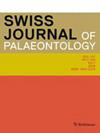Rare Middle Triassic coleoids from the Alpine-Carpathian system: new records from Slovakia and their significance
IF 3
2区 地球科学
Q1 PALEONTOLOGY
引用次数: 0
Abstract
Two stratigraphically well constrained (by ammonites and conodonts) coleoid remains have been recorded from the Triassic (Anisian) dark-grey organodetritic limestones (Ráztoka Limestone) of Western Carpathians (Hronic Nappe). The limestones deposited at the periphery of a former carbonate platform. It yields a highly diverse cephalopod fauna including nautiloids (2 taxa), ammonoids (7 taxa) and indetermined aulacoceratids. Two unusual coleoid specimens are referred to genus Mojsisovicsteuthis (M. boeckhi) and probably to a new taxon (described as Breviconoteuthis aff. breviconus herein) possessing similar morphological features of genus Breviconoteuthis (Phragmoteuthida) and/or Zugmontites. Based on index ammonites and conodonts, both records are of the uppermost Trinodosus through the lowermost Reitzi zones (Anisian—lower Illyrian). While the genus Mojsisovicsteuthis has been widely dispersed (however its records are rare), the occurrence of Breviconoteuthis and Zugmontites is strictly limited to the Alpine-Carpathian region. Comparing with the holotype and additional specimens stored in the Hungarian Natural History Museum, the overal shell of Mojsisovicsteuthis and its size has been reconstructed. Its relationship to aulacoceratids and phragmoteuthids is briefly discussed. Geochemical record (n-alkanes from the bulk rock) provided a relevant signal of the existence of algal meadows.阿尔卑斯-喀尔巴阡山系罕见的中三叠世柯叶植物:斯洛伐克的新记录及其意义
在喀尔巴阡山脉西部(赫罗尼克斜坡)的三叠纪(安息年)深灰色有机铁质石灰岩(Ráztoka 石灰岩)中,记录了两具在地层学上(通过氨虫和锥齿类)制约良好的鞘状遗骸。这些石灰岩沉积在前碳酸盐平台的外围。这里发现了种类繁多的头足类动物,包括鹦鹉螺类(2 个类群)、氨螺类(7 个类群)和未确定的乌头螺类。两个不寻常的壳类标本被归入 Mojsisovicsteuthis 属(M. boeckhi),也可能被归入一个新的类群(此处描述为 Breviconoteuthis aff.根据索引氨虫和锥齿类,这两个记录都属于最上层的Trinodosus到最下层的Reitzi区(安息年-下伊利里亚)。Mojsisovicsteuthis属的分布范围很广(但其记录却很少),而Breviconoteuthis和Zugmontites的出现则严格局限于阿尔卑斯-喀尔巴阡山地区。通过与保存在匈牙利自然历史博物馆的主模式和其他标本进行比较,我们重建了 Mojsisovicsteuthis 的外壳及其大小。本文还简要讨论了它与乌拉角龙类(aulacoceratids)和葭趾龙类(phragmoteuthids)的关系。地球化学记录(来自大块岩石的正烷烃)提供了藻类草甸存在的相关信号。
本文章由计算机程序翻译,如有差异,请以英文原文为准。
求助全文
约1分钟内获得全文
求助全文
来源期刊

Swiss Journal of Palaeontology
Earth and Planetary Sciences-Paleontology
CiteScore
4.30
自引率
16.70%
发文量
17
审稿时长
4 weeks
期刊介绍:
The Swiss Journal of Palaeontology publishes original research and review articles of interest to the international community in the fields of palaeontology, taxonomy and systematics, while recognising at the same time the importance of documenting high-quality palaeontological data in a regional context. Palaeobiology in combination with alpha taxonomy is a core topic of the journal.
Submitted papers should have an appeal as wide as possible, directed towards an international readership. Contributions should not have been simultaneously submitted elsewhere, and the overlap of content between related articles should be minimal. Duplications of text and the use of previously published illustrations without adequate citation are unacceptable. If a manuscript has two or more authors, both or all have to sign to confirm they all were involved in the work and have agreed to its submission. The preferred manuscript language is UK English, but consistently used US English is also acceptable. We encourage the publication of proceedings of international meetings as well as special thematic issues. Short contributions and book reviews are also accepted.
An international editorial team as well as guest editors guarantee that the thematic issues as well as all articles in regular issues are peer-reviewed and meet the highest standards.
 求助内容:
求助内容: 应助结果提醒方式:
应助结果提醒方式:


